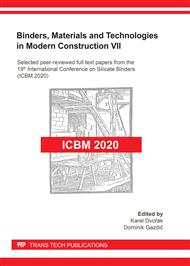p.40
p.47
p.53
p.59
p.65
p.71
p.79
p.86
p.92
Use of Spongilites as Pozzolanic Additives in Cement Mortars
Abstract:
In this study, the utilization of two types of spongilites in various addition in cement mortars has been investigated with the purpose of exploring a new application of this natural pozzolans as cement mortar additives. The influence of the addition of spongilites on the physico-mechanical properties, frost-resistance, and microstructure of cement mortars as a function of time was studied. The results revealed that the rising proportion of spongilites in cement mortars causes increase in water retention of mortars, reduction of their bulk density, increase in porosity of mortars due to the growing predominance of capillary pores maintaining sufficient mortars strengths, and slightly increase in the frost-resistance of mortars. After initial tests, partial replacement of cement in fine-grained cement mortars with hitherto unexploited spongilites seems to be very promising. Based on the achieved results, a 20% cement replacement can be recommended as optimal.
Info:
Periodical:
Pages:
65-70
Citation:
Online since:
October 2021
Authors:
Price:
Сopyright:
© 2021 Trans Tech Publications Ltd. All Rights Reserved
Share:
Citation:


